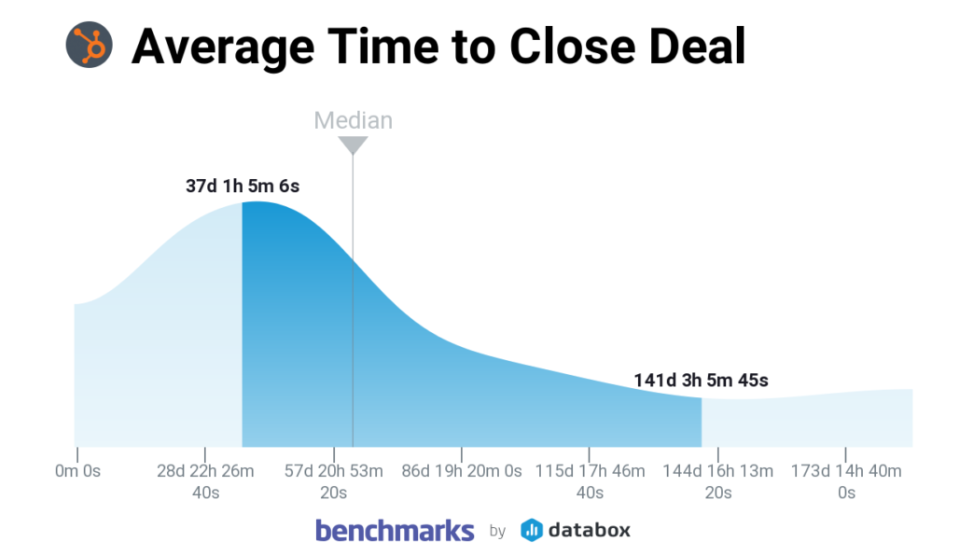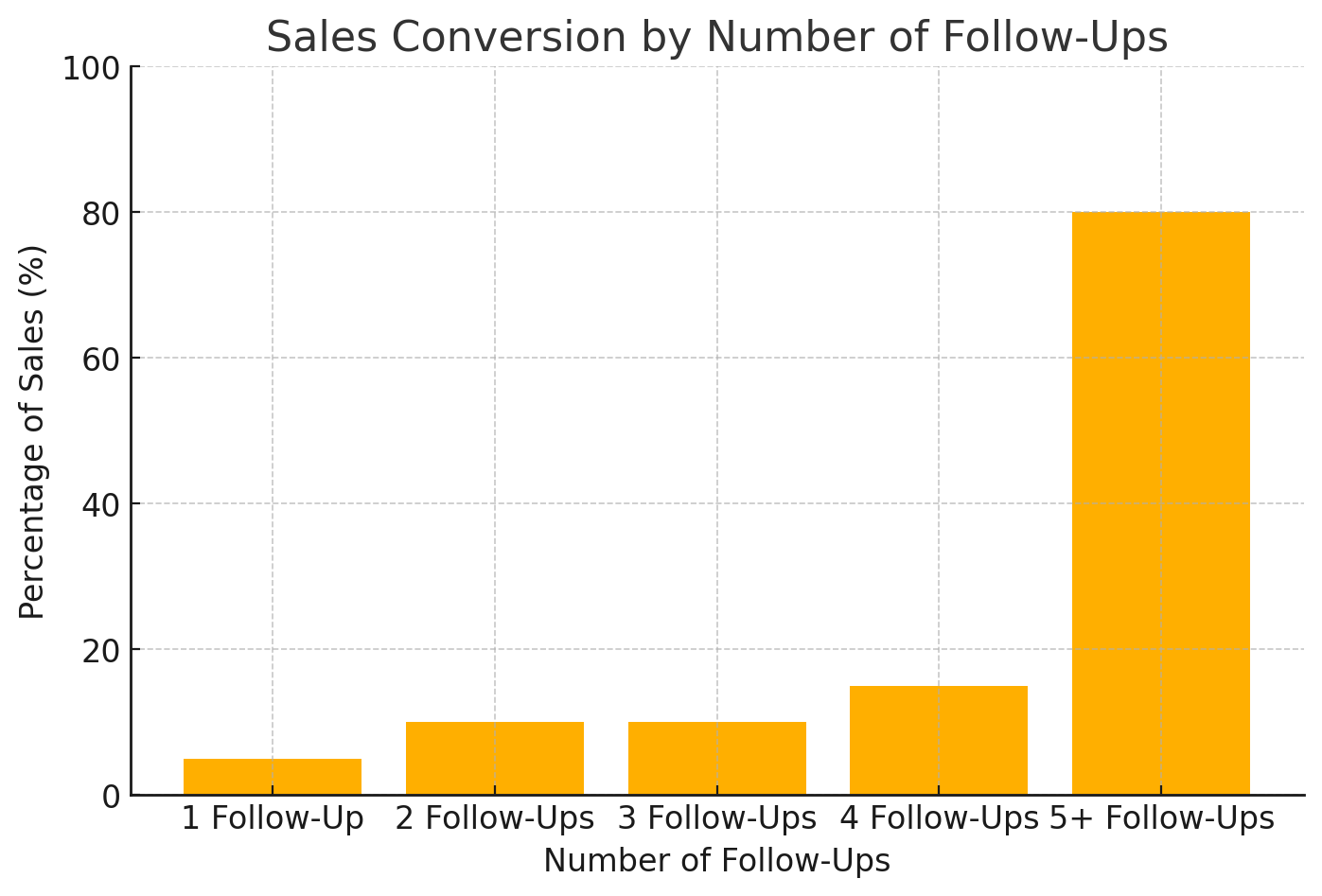In the IT sector, an extended sales cycle feels like a never-ending race, and it’s a significant obstacle to growth. Why does it matter? Every day a deal stays open, you could be losing it to your competitor. Plus, it lowers the morale of your sales team.
To make things worse, getting a prospect from first contact to a closed deal directly affects your income, resource distribution, and competitive advantage.
A study by Forrester shows that 74% of B2B buyers turn to the business that offers them the greatest value throughout the sales experience. That’s why your IT sales team has to work on making the buying process as easy and engaging as possible. Yet, with complex technical solutions, long decision-making processes, and the need to engage multiple stakeholders, the struggle is real.

Source: DataBox
To make your sales process lean, you need to understand and address these issues, allowing you to generate more revenue faster.
But what if your sales cycle is already stalled? How can you tell if a deal is about to slip through your fingers?
Five Indications Your Sales Cycle Is Going to Stall
How do you know that your sales cycle needs more effort from you and your team to make it shorter? Here are the five most common signs.
Unqualified Leads
Are you chasing ghosts? In the IT sector, chasing unqualified leads often means wasted time on prospects with no budget, an irrelevant tech stack, or no need for your solution. This not only slows your cycle but also drains morale.
HubSpot’s research shows that companies waste 27% of their time on unqualified leads. Before investing another minute, ensure your team is laser-focused on your ideal customer profile. Also, take your time to learn how to find decision makers.
Delayed Decision Making
Picture this. Your deal is stuck. And it feels like it is stuck forever in an endless committee meeting. IT sales involve so many decision makers (according to Gartner, the average B2B buying group is 6 to 10 people) – CIOs, CTOs, heads of the departments, and the list goes on and on. If you don’t have a key point of contact, or if they all can’t agree, you’ll see no progress with your deal.
It’s your job to ensure your sales team communicates this whole network effectively to move deals further.
Lack of Follow-Up
Are you fading into the background? Consistent and timely follow-ups are vital in the IT industry, where deals can be complex and take time. If your team isn’t keeping leads engaged, you risk them losing interest or turning to competitors.

A study by Sales Insights Lab showed that 80% of sales are made after at least 5 follow-ups. But simply following up isn’t enough. You need a strategic, value-driven approach.
Inefficient Processes
Take a look at your sales team’s daily routine. Are they spending hours doing too many things manually? All those spreadsheets, CRM data entry, and scheduling appointments manually? It’s time to automate this.
Your sales reps better focus on building relationships, understanding customer needs, and closing deals. All those manual tasks are a huge waste of time. To make things worse, they’re a morale killer, too!
The good news is that a study from McKinsey shows that automating even 30% of such tasks will surely increase your sales team’s productivity by 20%. Also, consider authoring the process of setting sales meetings to professional B2B appointment setting services to save time and energy of your sales reps on closing deals.
Misalignment with Customer Needs
If your sales messaging fails to connect with the particular pain points of IT decision-makers, moving leads forward to the next stage in your pipeline will be hard. Ensure your strategy addresses IT professionals’ unique challenges and priorities (cloud migration, cybersecurity, etc.).
A report from DemandGen shares that 61% of buyers feel that sellers do not understand their pain points. Are you confident that you are genuinely listening to your customers?
Okay, you’ve identified the warning signs. Now what? It’s time to make your IT sales process more efficient with our tips based on more than 21 years of experience in the IT sector.
Five Expert Tips to Speed Up Your B2B Sales Process
- Create Consistent Experiences Across Channels: Make sure your communication is consistent across every platform, from email to social networks. This reliability fosters trust and avoids confusion throughout the purchasing process. Outline all your communication strategies and offer essential training to your team to guarantee uniform messaging.
- Engage All Decision-Makers Early: Instead of postponing, engage all stakeholders in the sales process right from the beginning. Recognize their unique needs and issues, and customize your proposals to align with their priorities. This will assist you in sidestepping objections and accelerating the process. Research conducted by CEB (now known as Gartner) has discovered that transactions involving more stakeholders tend to have a greater likelihood of closing, showing a 16% rise in sales.
- Partner with Trusted Voices in the IT Space: Work with influencers, industry experts, and thought leaders who have already earned the trust of your desired audience. These collaborations will enhance your reputation and brand visibility while boosting the influx of quality leads. A recent LinkedIn study discovered that sales teams with elevated social selling scores generate 45% more sales opportunities.
- Leverage Social Selling: Interact with prospective clients on social media by posting informative content, joining important conversations, and being active in online groups. This enables you to develop relationships and create your brand while engaging with potential clients in their existing environments. Businesses that prioritize social selling often report win rates that are 14% higher compared to those that do not.
- Use Incentives to Accelerate Decisions: Provide incentives thoughtfully to promote faster decision-making. This may involve discounts, exclusive deals, or early-bird incentives. Utilize incentives thoughtfully and strategically to accelerate the sales process while ensuring customer satisfaction. A study published in the Journal of Marketing Analytics discovered that applying the appropriate incentive at the right moment can reduce the average sales cycle by as much as 10%.
Boost Your Success by Reducing Sales Cycle Lengths
Deeply Understand Your Buyer
Acquire a thorough comprehension of your customer’s needs, challenges, and purchasing journey. This allows you to customize your strategy and provide solutions that specifically target their challenges, thereby accelerating the sales cycle.
Examine their purchasing process by outlining each phase of the cycle. Firms that match their sales strategy with the buyer’s path experience an average revenue growth of 18% higher.

Develop a Streamlined Process
Think of your sales process as a carefully designed roadmap. Does it guide prospects smoothly from initial contact to a closed deal? Or is it a convoluted mess that causes confusion and delays?
To accelerate your cycle, you must use digital tools to generate personalized proposals, automate routine tasks, and track progress efficiently. In fact, companies that leverage a CRM typically see a 28% improvement in sales productivity. “Less wasted time, and more opportunities”
Maintain Open Lines of Communication
Picture a prospect left waiting for a response to a critical question for days. That’s a sure way to kill a deal. It’s crucial to provide frequent updates, quick answers, and clear action items. A buyer’s worst experience is a lack of assistance and attention. To get around this, you may want to establish clear communication guidelines for every sales rep in your team.
Implement Strategic Automation
“Technology will not replace the human element of the sales process, but will dramatically improve it.” Let technology work for you. By automating tedious tasks like follow-up, lead scoring, and appointment scheduling, your sales team can focus on building long-term, sustainable relationships. 78% of sales teams state that they have improved their lead quality by applying automation tools to the process.
Prioritize Leads with Qualification Criteria
Focus your team’s time on closing “sales qualified” leads that are a great fit to your product and are serious about working with you. Companies using a strict framework of identifying and qualifying leads are 30% more effective and get better ROI.
Address Objections Proactively
You cannot hope to avoid issues. Embrace them. Train the sales team to address concerns with clarity and confidence. Don’t let potential roadblocks turn into a wall. By solving the problem before it becomes too late, you also get higher conversion numbers.
Learn how to increase sales with b2b appointment setting techniques.
Highlighting Success (Example)
For instance, a recent case study highlighted that IT companies focusing on lead qualification saw a 20% reduction in their average sales cycle length. This demonstrates that a data-driven approach is crucial to improve sales performance.
Conclusion
By addressing the specific challenges that IT sales teams face and implementing these expert tips, you can significantly reduce your sales cycle length. This leads to faster revenue generation, increased efficiency, and a stronger competitive position. Do you need help shortening your sales cycle? Our performance-based approach allows us to guarantee results while reducing the risk for our clients.
Ready to grow like Hitachi or Fujitsu and add 2x more qualified sales meetings to your pipeline this month? Schedule your call today!